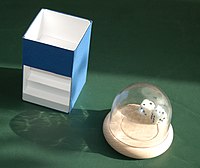Dice tower
A cube turret or latin a Turricula serves manipulations of throwing game dice excluded. The turricula is a small, open-top, cuboid box made of metal or wood, some with struts inside. The dice are thrown into the top of the tower and roll out again over inclined planes and steps at the front.
Turriculae were not only used for games of chance , but also for dice board games , such as the Ludus duodecim scripta , a forerunner of today's backgammon .
Cube towers can be found on many illustrations, but so far only two examples from late antiquity have been found:
- The wooden cube tower from Qustul is in the Egyptian Museum in Cairo .
- The beautifully crafted bronze turricula (around 368 AD) found in a Roman villa near Froitzheim in 1984 can be viewed in the Rheinisches Landesmuseum in Bonn . This is of high artistic value and has been embellished with two sayings in breakthrough work: Utere felix vivas (Use it with happiness and live!) And Pictos victos, hostis deleta. Ludite securi. (The Picts have been defeated, the enemies destroyed. Play safely!).
To prevent cheating in the game of dice , the Romans also used dice cups with lips to ensure that the dice bounced in any case. This idea, like the idea of the curriculum , has been taken up again in the present, the latter can be found in the so-called baffle boxes , which are sometimes used in backgammon.
The wrong game with marked dice cannot be prevented even when using a curriculum.
Board games that use a dice tower
literature
- Gipsy and Franz Baumann: Alea iacta est - Children play Romans , Ökotopia Verlag, Münster, 1998
